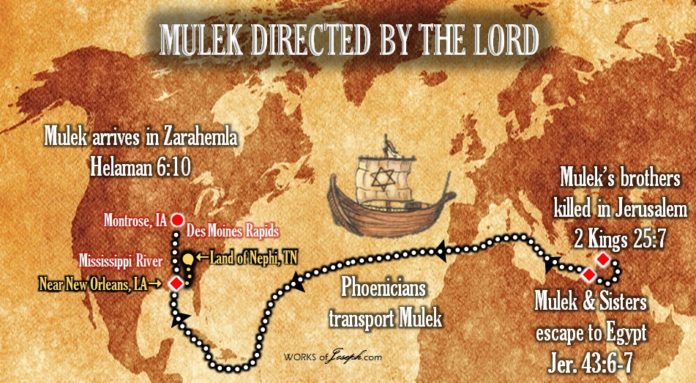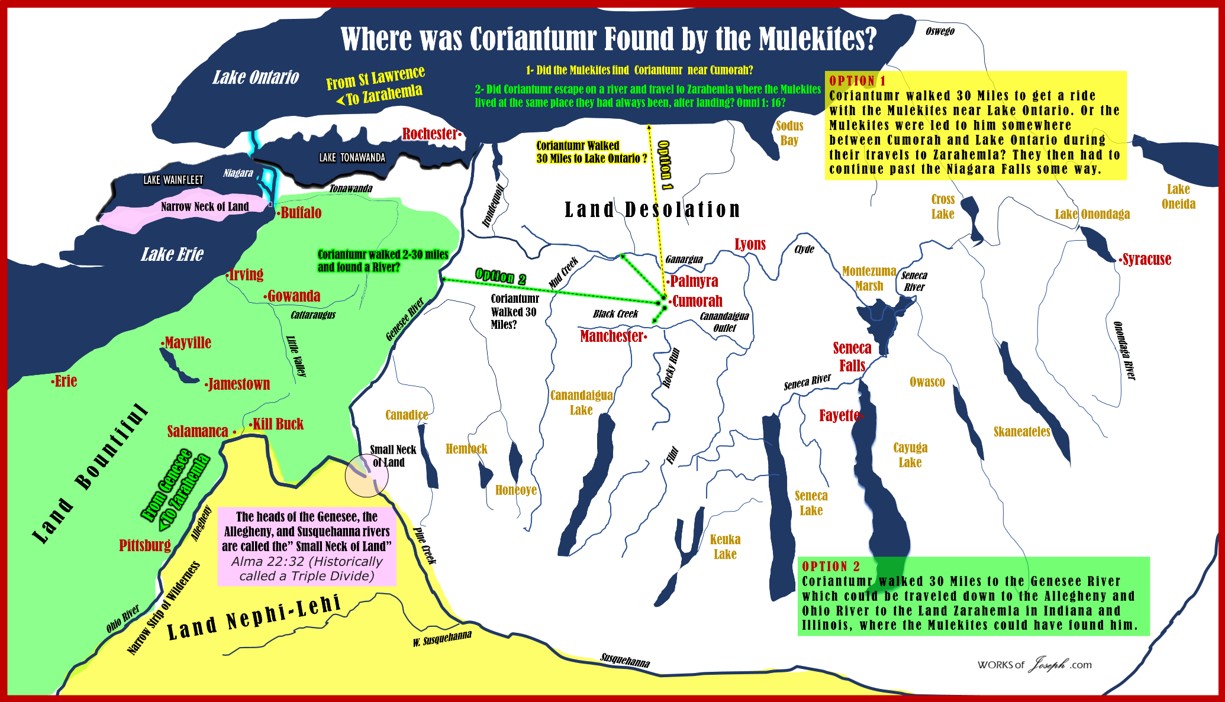A Non-LDS Navy Captains Expertise; Mulek- Up the Mississippi or through the St Lawrence?
With newly understood information from English Ship Captain Philip Beale, he has sailed 30,000 nautical miles that may indicate a very likely voyage of the Mulekites of the Book of Mormon traveling from the Old World to America using the southern route to the Gulf of Mexico and up the Mississippi River to Iowa.

The Phoenicia Voyages by Captain Philip Beale and Team are an ideal test of the veracity of the Book of Mormon accounts. Beale’s voyages of 2009 from Oman to Florida and a later voyage in 2020 from Tunisia to Florida, show not only that the materials and technology of 600 B.C. allowed construction of ocean-going vessels for both Lehi’s group and the Mulekites, but that both groups could have crossed the Atlantic and landed in North America, coming from the east.
As you see in the map below, you will see the Phoenicia Ship Expedition route in 2009 that demonstrated unequivocally that Lehi’s voyage could have left the Arabian Peninsula and sailed around Africa to Florida, rather than attempting to cross the earth’s largest ocean, the Pacific at its widest point, as proposed by many Mesoamerican theorists. The Phoenicia Expedition supports our vision, that Lehi’s Voyage to America was very possible.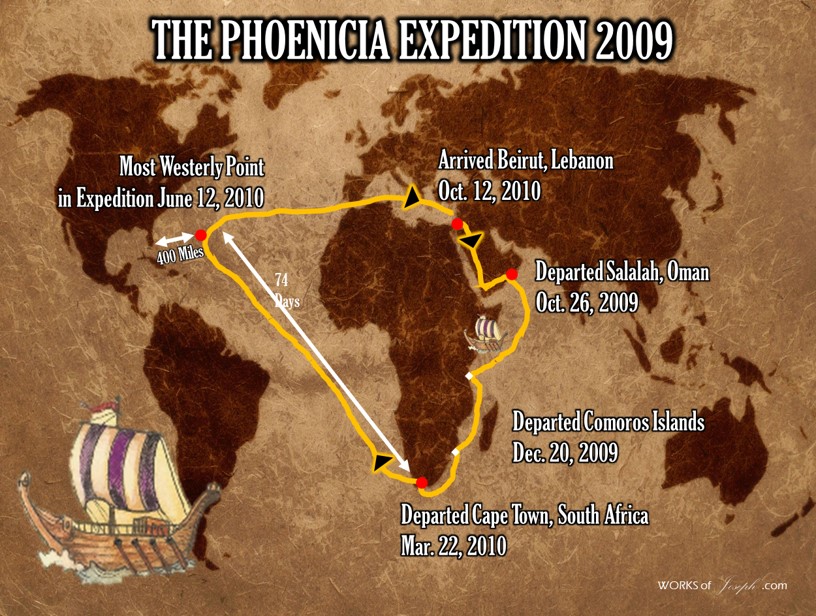
A second Phoenicia voyage below, also shows a path from Israel to Florida that Philip Beale took in his voyage of 2020, to show the very possible voyage of the Mulekites to America.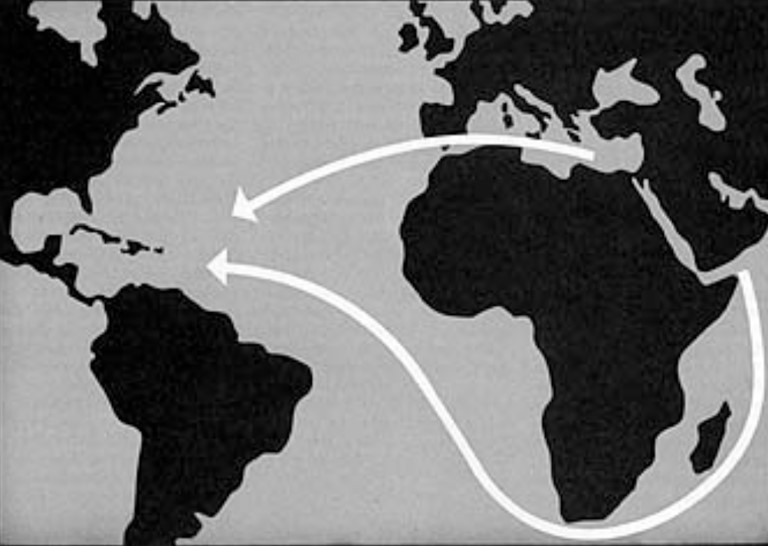
Possible Mulekite Voyage up the St Lawrence River

I would love your opinion on this post or at www.facebook.com/firmfoundationexpo
What is the 2020 Phoenician Expedition?
The Phoenicia is a traditionally-built replica of a Phoenician merchant vessel, based on a 600 BC design.
According to Greek geographer and historian, Strabo, the Phoenicians traded and settled along the East Atlantic coast, prompting our English friend Philip Beale’s belief in the likelihood that the Phoenicians would have attempted to sail West to America in the hope of discovering more lands.
Beale commissioned the building of the Phoenicia ship in about 2006. It was traditionally built in Syria and its design was based on the wreckage of the Jules Vernes 7, discovered in the Mediterranean in the early 1990’s. The Phoenicia is believed to be the only replica of its kind in the world.
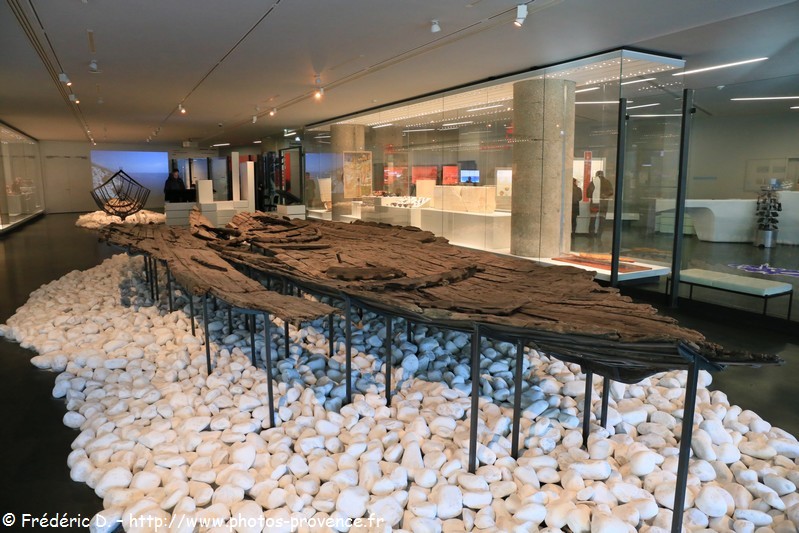
In Dec 2021, I sent the following email to Captain Beale:
Hi Philip:
I need your professional opinion as a navigator and ship Captain.
What are the advantages and disadvantages of a 600 BC ship to sail to Nauvoo, Illinois, USA.
We have two suggested paths and I would like a short answer of which pathway to Illinois would be most likely and why.
1. From Tunisia across the Atlantic similar to the path you took in 2020. Instead of landing on the East Coast of Florida the ship would continue around Miami and travel up the Mississippi River and stop in Illinois USA and Nauvoo?
2. Or from Tunisia going through Gibraltar, then heading north and entering the St Lawrence Seaway following the Great Lakes through Lake Ontario Lake, Erie through Lake Michigan then taking the Mississippi River south to Nauvoo Illinois?
I am just looking for a basic decision based on the information you have now, with a most likely scenario.
Thanks for your suggestion.
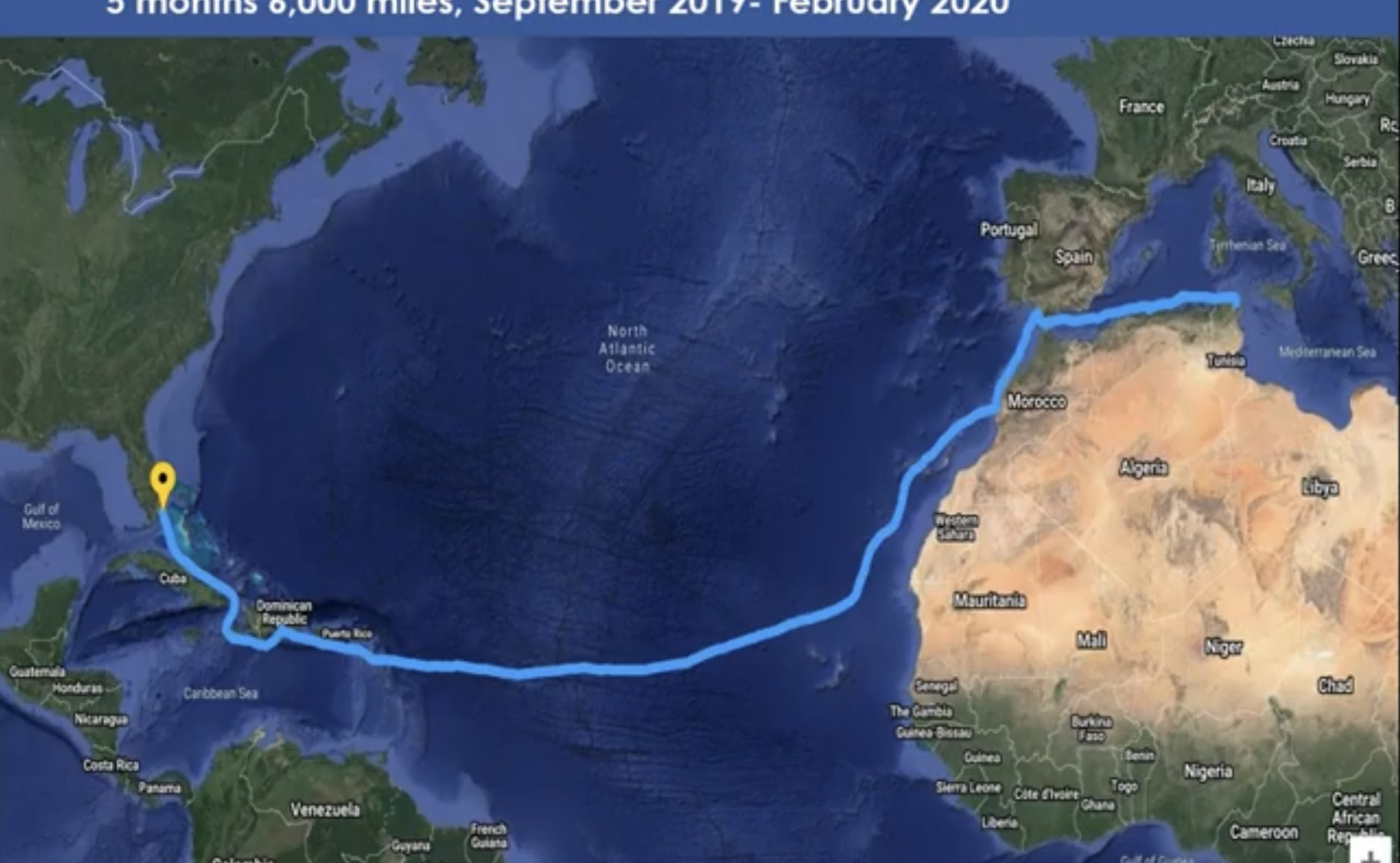
Captain Beale answered me with an email that said the following.
Hi Rian,
It is fairly straight forward I think.. the southern route is by far the easiest because of the prevailing winds and currents.
If you look at the Gulf stream that was first identified by Benjamin Franklin… from the Med. to the Caribbean is a simple conveyer belt.(See Map Below)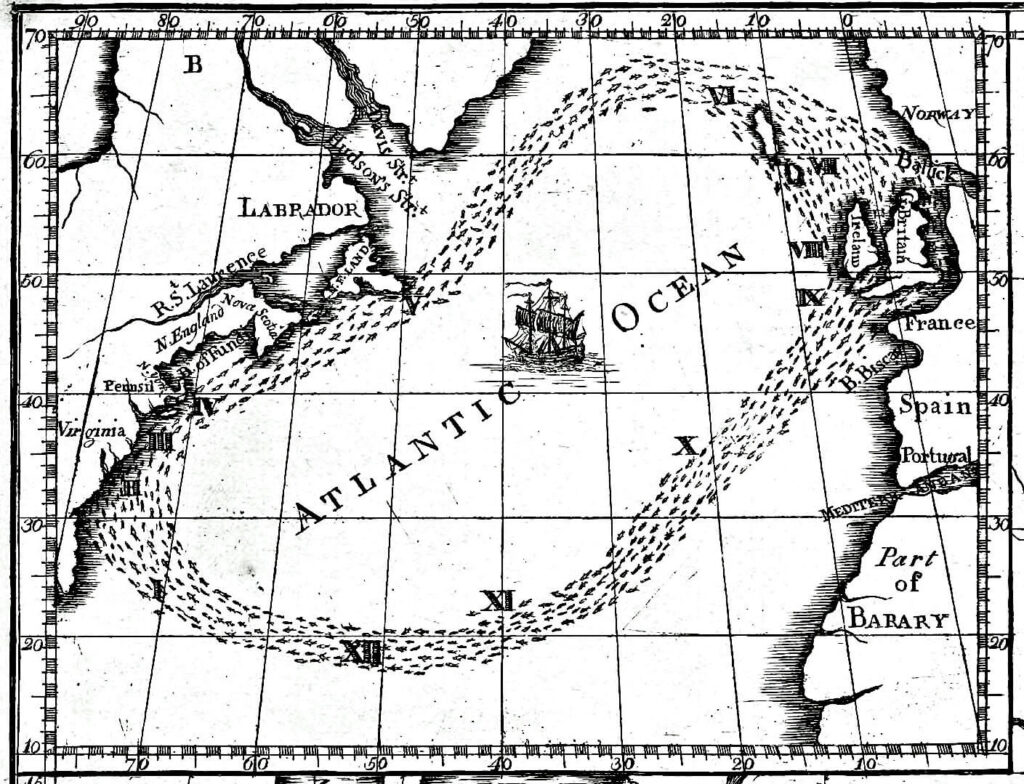
The winds and current are pretty much in synch most of the year and in the north north Atlantic the prevailing winds are West to East.. so very difficult for the Phoenicians to have gone the northern route.” Hope that helps. Philip Beale
Additional Philip Beale Email
“Thanks for your email the other day and sorry for my delayed response.
I think in general the so called Northern route is a non-starter for an historical/maritime point of view because as you will see from the attached chart, the currents and winds (which have been the same for thousands of years) go against the northern route. Unless the Phoenicians invented the internal combustion engine or sailed to meet the Vikings first in Norway, it just does not make sense.
However the southern route is just like a conveyer belt all the way to the Caribbean from the Med. For the rivers we would have to look at the distances involved but I think at best you would be looking at 10 miles per day through rowing.
Happy to do a bit more work on this but I thought I would send this to get started.”
Regards Captain Philip Beale

Read at the bottom of the page about Capt. Beale’s voyage called the Phoenicia Expedition – Tunisia to Florida 2020
Below is evidence of a possible Mulekite Landing at Nauvoo Illinois from Moroni’s America.
“ALTHOUGH SHORT, THE BOOK OF OMNI CONTAINS critical geographical information that illuminates the rest of the book. Omni was the next-to-the-last book that Joseph translated. He and Oliver had moved from Harmony, Pennsylvania, to the Peter Whitmer farm in New York. They were days away from the manifestations to the Three Witnesses and the Eight Witnesses. It was the culmination of a difficult but thrilling process. People recorded that when Joseph and Oliver came downstairs after working on the translation, they glowed. Oliver began working as scribe in Harmony, Pennsylvania, in April 1829 with what is now Mosiah 1. Historical documents suggest that Mosiah 1 was originally the third chapter of Mosiah; the first two chapters, and everything leading up to that, were part of the manuscript that Martin Harris lost. We don’t know how much of what is contained in Omni was also contained in that lost manuscript, but it is remarkable how this brief book ties together several loose threads from the nearly 500 pages that follow it—and preceded it in the translation process.” Jonathan Neville
Below is from Moroni’s America by Jonathan Neville page 99-106 Omni 1:15-19 At first, Mosiah and his people could not communicate with the people of Zarahemla with language because “their language had become corrupted and they had brought not records with them.” As Mosiah soon found out, the people of Zarahemla—their ancestors, actually—came out from Jerusalem. Because Mosiah’s ancestors, too, came out from Jerusalem, it may seem surprising that the two groups could not communicate. Scholars debate about how long it takes for languages to change, but another possibility is that the Mulekites—the common name for the people of Zarahemla—were brought to the New World by Phoenician sailors.(108) Perhaps the Mulekites adopted the Phoenician language or mixed it with their own. The use of Phoenician names such as Sidon and Isabel is further evidence of the Phoenician influence. (109) Once he learned Mosiah’s language, Zarahemla himself “gave a genealogy of his fathers, according to his memory.” Unfortunately, we don’t have that record. But it was presumably from Zarahemla that Mosiah learned about how Zarahemla’s ancestors “came out from Jerusalem at the time that Zedekiah, king of Judah, was carried away captive into Babylon.” Mulek was the son of Zedekiah who escaped captivity; hence the term Mulekites, which is actually not found in the scriptures. Mulek and his companions “journeyed in the wilderness and were brought by the hand of the Lord across the great waters into the land where Mosiah discovered them and they had dwelt there from that time forth.” This verse tells us the Mulekites “journeyed in the wilderness” but doesn’t reveal how long they journeyed or how far they went.
They left Jerusalem, where Mulek’s brothers had been killed (2 Kings 25:7) and his father blinded before being taken captive, and reached a port. Most likely, they went to Egypt, since that is where his sisters and others found refuge (Jeremiah 43:6-7). From Egypt, the Phoenicians would have transported Mulek and his group west through the Mediterranean, passing the Iberian Peninsula and across the Atlantic to the New World. They likely followed a route similar to that of Columbus and other explorers who left from the Mediterranean. A key point here is that they were led by the Lord “into the land where Mosiah discovered them and they had dwelt there from that time forth.” How would they have reached Iowa directly? And why would they have remained there for hundreds of years?
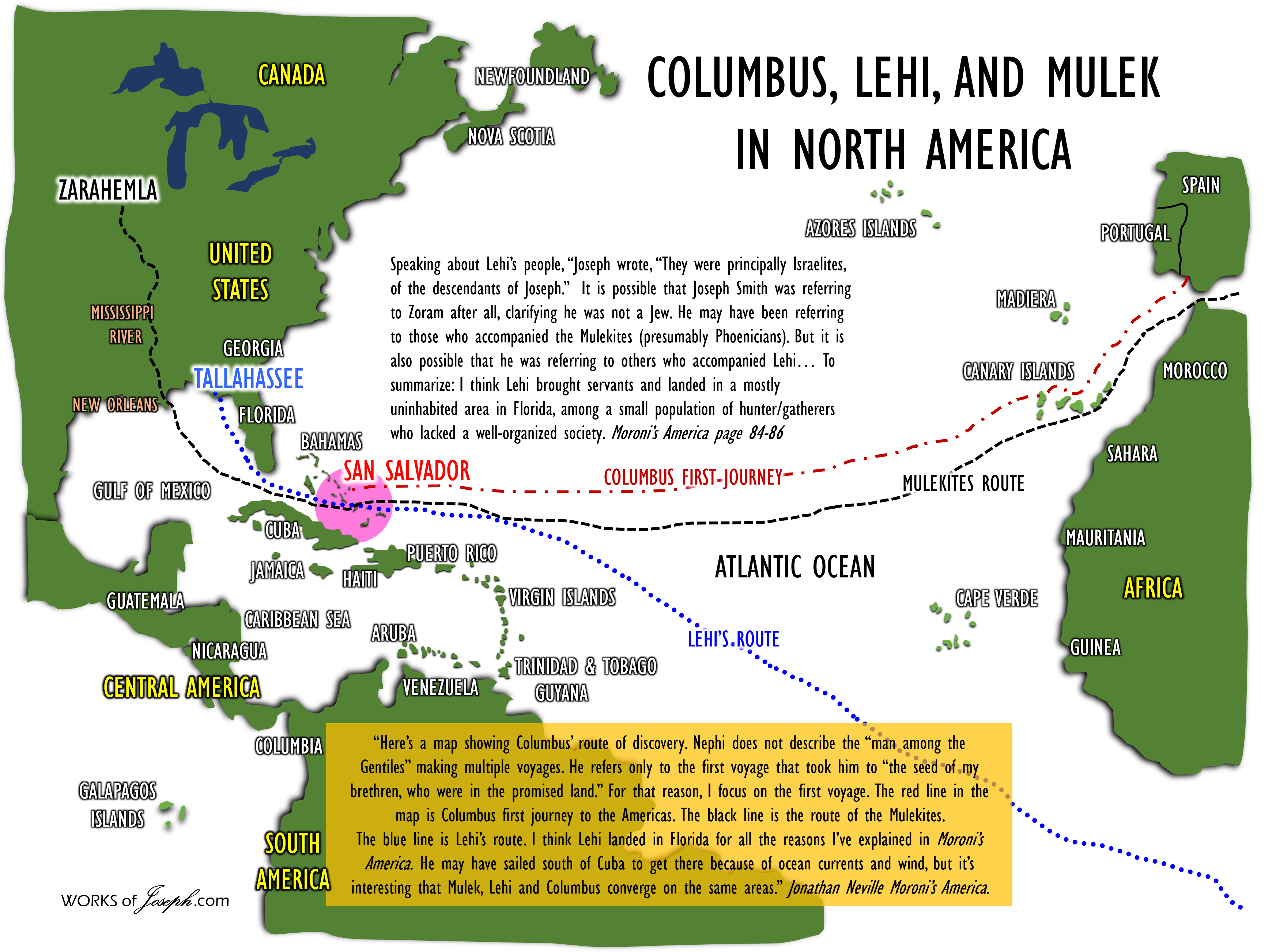 There is a good reason why the Mulekites would have stopped in Iowa, across from Nauvoo. It is the first place up the Mississippi river from the Gulf Coast that, historically, was impassable for large ships, due to the Des Moines rapids located just south of there. Even in the 1840s, riverboats had to stop at the rapids, unload cargo, and then be dragged over the rapids before progressing north. (Now, a series of dams and locks makes the river navigable for barges and other large ships.) Lewis and Clark noted the rapids on their 1814 map. In 1837, Robert E. Lee made a map showing the rapids by Fort Des Moines, where Montrose, Iowa, is today.
There is a good reason why the Mulekites would have stopped in Iowa, across from Nauvoo. It is the first place up the Mississippi river from the Gulf Coast that, historically, was impassable for large ships, due to the Des Moines rapids located just south of there. Even in the 1840s, riverboats had to stop at the rapids, unload cargo, and then be dragged over the rapids before progressing north. (Now, a series of dams and locks makes the river navigable for barges and other large ships.) Lewis and Clark noted the rapids on their 1814 map. In 1837, Robert E. Lee made a map showing the rapids by Fort Des Moines, where Montrose, Iowa, is today.  Picture left shows another key point. The Mulekites could have easily sailed up the river without encountering the Nephites or the Lamanites, who were several hundred miles east. Furthermore, the Mulekites would have sailed right past other civilizations that likely existed in the area, descendants of Jaredites or other groups who had come to the continent. The Zarahemla location in Iowa, across from Nauvoo, is ideal from several perspectives. First, being on the river provides plentiful water and facilitates commerce. Second, it is upriver from the Des Moines rapids, which provide a defensive barrier against river-borne invaders from the south. Third, the area has productive agricultural land. Ultimately, of course, it’s where the Lord led them.
Picture left shows another key point. The Mulekites could have easily sailed up the river without encountering the Nephites or the Lamanites, who were several hundred miles east. Furthermore, the Mulekites would have sailed right past other civilizations that likely existed in the area, descendants of Jaredites or other groups who had come to the continent. The Zarahemla location in Iowa, across from Nauvoo, is ideal from several perspectives. First, being on the river provides plentiful water and facilitates commerce. Second, it is upriver from the Des Moines rapids, which provide a defensive barrier against river-borne invaders from the south. Third, the area has productive agricultural land. Ultimately, of course, it’s where the Lord led them.
This geography helps clarify why the Nephites never encountered Zarahemla until Mosiah was prompted to flee from the land of Nephi. In our day, we might think people would explore freely, but anciently, the wilderness was dangerous. There were wild beasts, unpredictable weather, the potential of getting lost, sicknesses, and no way to communicate over long distances. You were on your own in the wilderness. By contrast, there was safety in numbers and community. Farms provided food. Why risk leaving a safe, productive and favorable location? It required great faith for Lehi and his family to leave Jerusalem, let alone cross the ocean (which is why Nephi faced such resistance from his brothers). In the new world, it required great faith for Nephi to flee from his brothers into the wilderness. Mosiah exercised great faith to leave the land of Nephi. The prominence of Zarahemla—it is by far the most-often mentioned place in the Book of Mormon, the capital of the Nephites—shows it was wise for the people of Zarahemla to stay put. Omni 1:20-22

And it came to pass in the days of Mosiah there was a large stone brought unto him with engravings on it and he did interpret the engravings by the gift and power of God. And they gave an account of one Coriantumr and the slain of his people. And Coriantumr was discovered by the people of Zarahemla; and he dwelt with them for the space of nine moons. It also spake a few words concerning his fathers. And his first parents came out from the tower at the time the Lord confounded the language of the people and the severity of the Lord fell upon them according to his judgments which are just and their bones lay scattered in the land northward. The sequence of events shows that Zarahemla had not mentioned Coriantumr or the Jaredites to Mosiah before the stone was brought forth. The parenthetical—“And Coriantumr was discovered by the people of Zarahemla; and he dwelt with them for the space of nine moons”—is ambiguous. The information could have been taken from the engravings, or perhaps the bringing of the stone prompted Zarahemla to tell Mosiah that his people had discovered Coriantumr. The text doesn’t say when Coriantumr lived. It could have been during Zarahemla’s lifetime or much earlier. (110) Either way, there is no indication that the people of Zarahemla had themselves discovered any Jaredite remains. Everything Mosiah learned about the Jaredites at this point came from his translation of the engravings on the stone.
This is important because it corroborates Amaleki’s statement that the Lord led the Mulekites to the land where they settled and they never left that land. If they went directly to Iowa, then they never visited the land where the Jaredites lived and were ultimately destroyed—i.e., Cumorah. The printed text does not retain the capitalization found in the printer’s manuscript on the assumption that capitalization was random. The printer’s manuscript capitalizes the word “Northward” here, suggesting it may be a proper noun. Some instances in the printer’s manuscript capitalize northward, while others do not. [NOTE: The account in Omni is straightforward, but some commentators have confused it with what happened when King Limhi sent a search party of 43 men who inadvertently discovered the Jaredites and their record in Mosiah 8:7-12. I will address that in the Mosiah chapter.] What about Coriantumr? How did the people of Zarahemla discover him if they didn’t discover the land where the Jaredites were destroyed? And where did the stone come from?
Ether, the final Jaredite prophet, had told Coriantumr that if he didn’t repent, “he should only live to see the fulfilling of the prophecies which had been spoken concerning another people receiving the land for their inheritance and Coriantumr should receive a burial by them and every soul should be destroyed save it were Coriantumr.” Ether 13:21. Just a few verses previously, Ether had also prophesied about the New Jerusalem. 2 For behold, they [the Jaredites] rejected all the words of Ether; for he truly told them of all things, from the beginning of man; and that after the waters had receded from off the face of this land it became a choice land above all other lands, a chosen land of the Lord; wherefore the Lord would have that all men should serve him who dwell upon the face thereof; 3 And that it was the place of the New Jerusalem, which should come down out of heaven, and the holy sanctuary of the Lord. 4 Behold, Ether saw the days of Christ, and he spake concerning a New Jerusalem upon this land. (Ether 13:2-4)
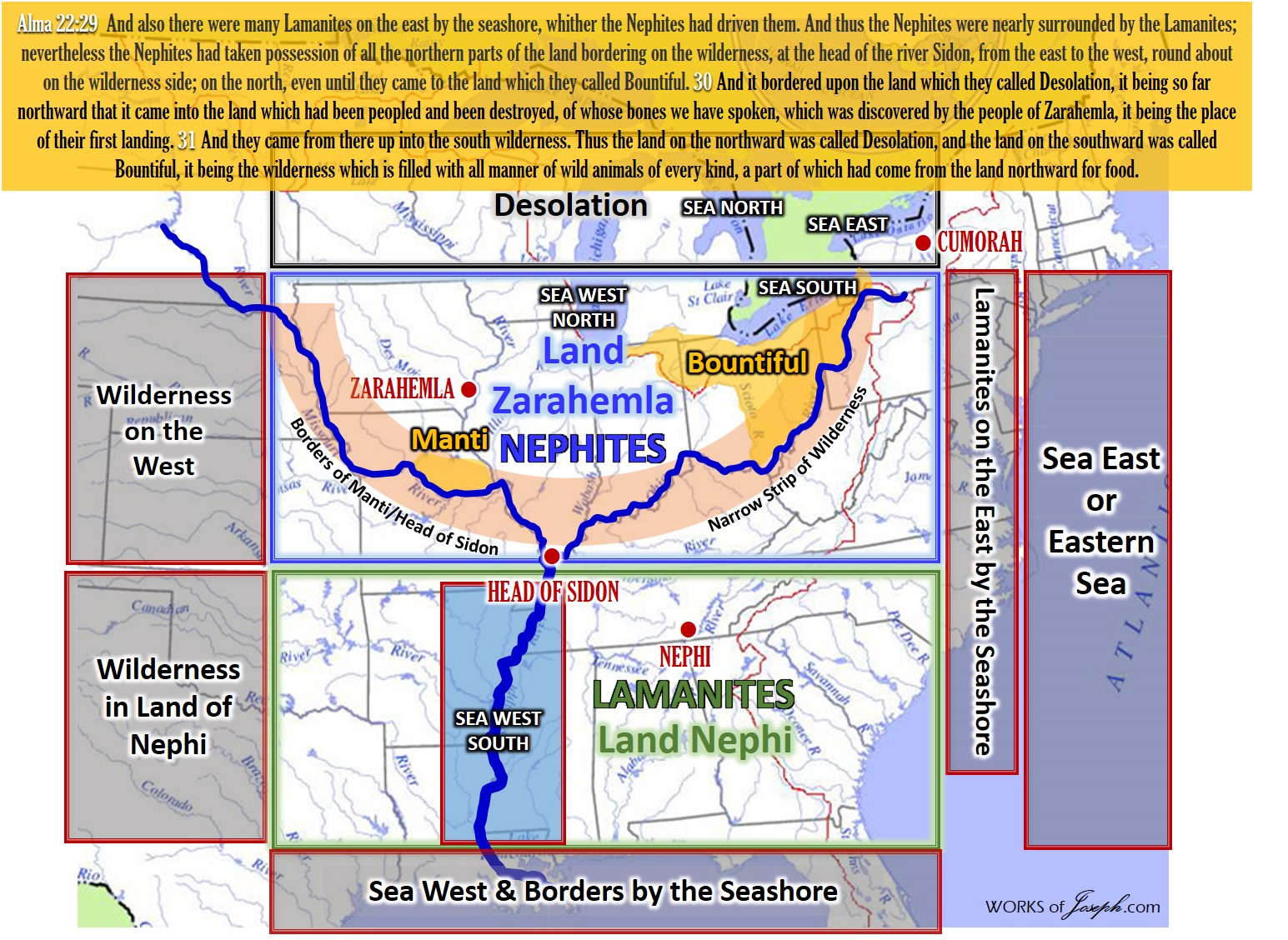
As the sole survivor of the final battle, living all by himself in Cumorah (Ether having either died or declined to join him), Coriantumr surely would have remembered Ether’s prophecies. Ether correctly prophesied that Coriantumr would be the sole survivor; wouldn’t Coriantumr therefore believe that the New Jerusalem would come? Ether had referred to it coming to “this land” which was “a chosen land,” just as he told Coriantumr that “another people” would receive “the land for their inheritance.” Coriantumr could reasonably conclude that the site of the New Jerusalem would be where he would meet the new people who were to receive the land for their inheritance. From D&C 84:1-5, we know the New Jerusalem will be “in the western boundaries of the State of Missouri.” How would Coriantumr get there from Cumorah? One route would be to travel south on the Allegheny River to the Ohio River, then south and west to the Mississippi River on his way to the Missouri River, which leads directly to the New Jerusalem.
Along the way, probably while on the Mississippi, he was apparently found by the people of Zarahemla, who took him in for nine months before he died. As for the stone, I think Coriantumr carved it during those nine months he lived with the people of Zarahemla. There is no indication in Omni that Coriantumr communicated with the people. They would have had completely different languages. Unlike the situation with Mosiah, who at least shared a common Israelite ancestry and culture with the people of Zarahemla, nothing about Coriantumr’s Jaredite culture would be familiar. The people of Zarahemla did not keep records and apparently had no writing system, since Zarahemla recounted his genealogy by memory. Coriantumr, having seen another of Ether’s prophecies fulfilled—that he would see another people receive the land for their inheritance—would have wanted to leave a record of his people and his own life. Engraving a stone would probably be the only method available to do so. (Even if he knew Ether kept a record, Coriantumr would have no way of knowing what became of Ether’s plates.) Coriantumr knew the people of Zarahemla wouldn’t understand his engravings, but figured that eventually, someone would decipher it. His hopes were realized when Mosiah arrived.
NOTES [108] John Sorenson wrote, “It is very likely that non-Jews were in the crew of the vessel that brought Zedekiah’s son Mulek to the New World (see Omni 1:15-16). A purely Israelite crew recruited in the Palestine homeland would have been possible during some periods, but at the time Mulek’s party left, all the Mediterranean ports of the kingdom of Judah were in Babylonian hands. Most likely the crew of the ship (there could have been more than one, of course) were ‘Phoenician,’ itself a historical category that was by no means homogenous.” John L. Sorenson, “When Lehi’s Party Arrived in the Land, Did They Find Others,” Journal of Book of Mormon Studies, Vol. 1 Fall 1992 (Provo, Utah, FARMS),
13. [109] Hugh Nibley noted that Sidon is the name of the Phoenician harbor in what is now Lebanon. The city still bears that name. Of course, the name also appears in the Old Testament as part of a border description (Genesis 10:19). Isabel, the harlot Alma chastised his son Corianton for visiting in Alma 39:3, is also “the name of the Patroness of Harlots in the religion of the Phoenicians.” Nibley, “The Book of Mormon: Forty Years After,” in The Prophetic Book of Mormon (Deseret Book/FARMS 1992) available online at http://bit.ly/Moroni59.
Siron is another possible Phoenician influence. The Book of Mormon Onomasticon notes, “Given the possibility of Phoenician influence on the Mulekites who first settled the land around ZARAHEMLA,[1] this GN [given name] may be identical to the biblically attested Phoenician name for Mount Hermon, namely, śiryôn (Deuteronomy 3:9 and Psalms 29:6), Sirion in KJV (JH, JAT).[2]. Notice also the similar biblical word siryôn which in Jeremiah 46:4 and 51:3 is a type of body armor (JH). http://bit.ly/Moroni60 [110] Estimates for the final battle of the Jaredites range from 580 B.C. to 400 B.C. (Sorenson, An Ancient American Setting, p. 119) or as late as 200 B.C. (Gardner, Traditions of the Fathers, p. 391). This question is addressed in the Mosiah and Ether chapters.
Phoenicia Expedition – Tunisia to Florida 2020 Evidence of a possible Mulekite Landing at Nauvoo Illinois
What is the 2020 Phoenician Expedition?
The Phoenicia is a traditionally-built replica of a Phoenician merchant vessel, based on a 600 BC design.
According to Greek geographer and historian, Strabo, the Phoenicians traded and settled along the East Atlantic coast, prompting Philip Beale’s belief in the likelihood that the Phoenicians would have attempted to sail West in the hope of discovering more lands.
Beale commissioned the building of the Phoenicia ship 12 years ago. It was traditionally built in Syria and its design was based on the wreckage of the Jules Vernes 7, discovered in the Mediterranean in the early 1990’s. The Phoenicia is believed to be the only replica of its kind in the world.

This voyage (From Tunisia began the 28th of Sept 2019 and Landed in Ft Lauderdale FL on Feb 4, 2020), has proved it possible for the ancient Mulekites to have traveled from Tunisia (Ancient Capital of the Phoenicians), all the way to Florida where we feel the Mulekites traveled up the Mississippi (Sidon) River, and were forced to stop at the DeMoines River rapids near Nauvoo, IL. For an explanation see my blog article here called, Mulekites Land Near Nauvoo
Watch below for the Phoenicia Expedition Connection with the Book of Mormon
Read about Boyd Tuttle and the Phoenician Expedition in LDS Living and on my blog here called, Columbus wasn’t the First to Discover America!

I believe the Mulekites traveled the same path as the Phoenician Expedition has just made. Philip Beale a British sailor and ship will arrive in Ft Lauderdale Florida from Tunisia on Tuesday Feb 4th. It has been a voyage of about 4 months since Boyd Tuttle left with the ship. It is very probable that the Mulekites traveled into the Gulf of Mexico near New Orleans and traveled up the Mississippi (Sidon) River and stopped near Nauvoo.
I also believe the Phoenicians are related to the Cherokee Indians and many others you may be surprised about. See my blog here titled, Cherokee/Phoenician DNA Connection

(Quote from my blog above). The Phoenicians’ name in their own Semitic language translates as “Canaanite,” a reflection of their origins in the East Mediterranean. James Adair, who wrote the first book about American Indians in 1775, suggested this ethnonym (national identity) appears in the name of the Kanawha River and as the name of a now-extinct Indian tribe in Kentucky and West Virginia. Phoenicians are probably also the source of haplogroup X in the New World, and they are implicated in the mystery of the Melungeon people, with court cases mentioning them by name. See DNA Blog called, Lamanites are Descendants of the Jews.
Read the article below written by the ship crew and learn about there just finished voyage and how you may be able to help them in their desire for donations:
>Donate Here<
A goal of the Heartland Group including Mike and Betty LaFontaine, and John Lefgren was to purchase the Phoenicia Ship and dock it across the river from Nauvoo, IL at Montrose IA. They have succeeded with the purchase from Philip Beale, and they are now rebuilding it. You can assist them in volunteering or donating by visiting them here:phoenicia.rocks They are also building a large Museum all about the Phoenicia.

